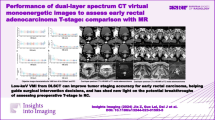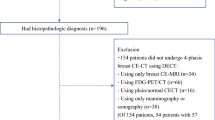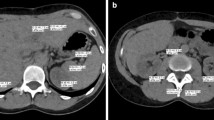Abstract
Purpose
The aim of this study was to evaluate the impact of a noise-optimized virtual monoenergetic imaging (VMI+) reconstruction technique on quantitative and qualitative image analysis in patients with gastrointestinal stromal tumors (GISTs) at dual-energy computed tomography (DECT) of the abdomen.
Methods
Forty-five DECT datasets of 21 patients (14 men; 63.7 ± 9.2 years) with GISTs were reconstructed with the standard linearly blended (M_0.6) and VMI+ and traditional virtual monoenergetic (VMI) algorithm in 10-keV increments from 40 to 100 keV. Attenuation measurements were performed in GIST lesions and abdominal metastases to calculate objective signal-to-noise (SNR) and contrast-to-noise ratios (CNR). Five-point scales were used to evaluate overall image quality, lesion delineation, image sharpness, and image noise.
Results
Quantitative image parameters peaked at 40-keV VMI+ series (SNR 27.8 ± 13.0; CNR 26.3 ± 12.7), significantly superior to linearly blended (SNR 16.8 ± 7.3; CNR 13.6 ± 6.9) and all VMI series (all P < 0.001). Qualitative image parameters were highest for 60-keV VMI+ reconstructions regarding overall image quality and image sharpness (median 5, respectively; P ≤ 0.023). Qualitative assessment of lesion delineation peaked in 40 and 50-keV VMI+ series (median 5, respectively). Image noise was superior in 90 and 100-keV VMI and VMI+ reconstructions (all medians 5).
Conclusions
Low-keV VMI+ reconstructions significantly increase SNR and CNR of GISTs and improve quantitative and qualitative image quality of abdominal DECT datasets compared to traditional VMI and standard linearly blended image series.



Similar content being viewed by others
References
Burkill GJ, Badran M, Al-Muderis O, et al. (2003) Malignant gastrointestinal stromal tumor: distribution, imaging features, and pattern of metastatic spread 1. Radiology 226:527–532
Joensuu H, Hohenberger P, Corless CL (2013) Gastrointestinal stromal tumour. Lancet 382:973–983
DeMatteo RP, Lewis JJ, Leung D, et al. (2000) Two hundred gastrointestinal stromal tumors: recurrence patterns and prognostic factors for survival. Ann Surg 231:51–58
Suster S (1996) Gastrointestinal stromal tumors. Semin Diagn Pathol 13:297–313
Miettinen M, Lasota J (2001) Gastrointestinal stromal tumors–definition, clinical, histological, immunohistochemical, and molecular genetic features and differential diagnosis. Virchows Arch 438:1–12
Mabille M, Vanel D, Albiter M, et al. (2009) Follow-up of hepatic and peritoneal metastases of gastrointestinal tumors (GIST) under Imatinib therapy requires different criteria of radiological evaluation (size is not everything!!!). Eur J Radiol 69:204–208
Benjamin RS, Choi H, Macapinlac HA, et al. (2007) We should desist using RECIST, at least in GIST. J Clin Oncol 25:1760–1764
Apfaltrer P, Meyer M, Meier C, et al. (2012) Contrast-enhanced dual-energy CT of gastrointestinal stromal tumors: is iodine-related attenuation a potential indicator of tumor response? Investig Radiol 47:65–70
Heye T, Nelson RC, Ho LM, Marin D, Boll DT (2012) Dual-energy CT applications in the abdomen. Am J Roentgenol 199:S64–S70
Schabel C, Bongers M, Sedlmair M, et al. (2014) Assessment of the hepatic veins in poor contrast conditions using dual energy CT: evaluation of a novel monoenergetic extrapolation software algorithm. Rofo 186:591–597
Sudarski S, Apfaltrer P, Nance JW Jr, et al. (2014) Objective and subjective image quality of liver parenchyma and hepatic metastases with virtual monoenergetic dual-source dual-energy CT reconstructions: an analysis in patients with gastrointestinal stromal tumor. Acad Radiol 21:514–522
Grant KL, Flohr TG, Krauss B, et al. (2014) Assessment of an advanced image-based technique to calculate virtual monoenergetic computed tomographic images from a dual-energy examination to improve contrast-to-noise ratio in examinations using iodinated contrast media. Investig Radiol 49:586–592
Albrecht MH, Scholtz JE, Kraft J, et al. (2015) Assessment of an advanced monoenergetic reconstruction technique in dual-energy computed tomography of head and neck cancer. Eur Radiol 25:2493–2501
Wichmann JL, Noske EM, Kraft J, et al. (2014) Virtual monoenergetic dual-energy computed tomography: optimization of kiloelectron volt settings in head and neck cancer. Investig Radiol 49:735–741
Albrecht MH, Scholtz JE, Husers K, et al. (2016) Advanced image-based virtual monoenergetic dual-energy CT angiography of the abdomen: optimization of kiloelectron volt settings to improve image contrast. Eur Radiol 26:1863–1870
Frellesen C, Kaup M, Wichmann JL, et al. (2016) Noise-optimized advanced image-based virtual monoenergetic imaging for improved visualization of lung cancer: comparison with traditional virtual monoenergetic imaging. Eur J Radiol 85:665–672
Albrecht MH, Trommer J, Wichmann JL, et al. (2016) Comprehensive comparison of virtual monoenergetic and linearly blended reconstruction techniques in third-generation dual-source dual-energy computed tomography angiography of the thorax and abdomen. Investig Radiol 51:582–590
Kim KS, Lee JM, Kim SH, et al. (2010) Image fusion in dual energy computed tomography for detection of hypervascular liver hepatocellular carcinoma: phantom and preliminary studies. Investig Radiol 45:149–157
Sudarski S, Apfaltrer P, Nance JW Jr, et al. (2013) Optimization of keV-settings in abdominal and lower extremity dual-source dual-energy CT angiography determined with virtual monoenergetic imaging. Eur J Radiol 82:e574–e581
Beeres M, Trommer J, Frellesen C, et al. (2016) Evaluation of different keV-settings in dual-energy CT angiography of the aorta using advanced image-based virtual monoenergetic imaging. Int J Cardiovasc Imaging 32:137–144
Martin SS, Albrecht MH, Wichmann JL, et al. (2016) Value of a noise-optimized virtual monoenergetic reconstruction technique in dual-energy CT for planning of transcatheter aortic valve replacement. Eur Radiol . doi:10.1007/s00330-016-4422-3
De Cecco CN, Caruso D, Schoepf UJ, et al. (2016) Optimization of window settings for virtual monoenergetic imaging in dual-energy CT of the liver: a multi-reader evaluation of standard monoenergetic and advanced imaged-based monoenergetic datasets. Eur J Radiol 85:695–699
Shrout PE, Fleiss JL (1979) Intraclass correlations: uses in assessing rater reliability. Psychol Bull 86:420–428
De Cecco CN, Darnell A, Macias N, et al. (2013) Second-generation dual-energy computed tomography of the abdomen: radiation dose comparison with 64- and 128-row single-energy acquisition. J Comput Assist Tomogr 37:543–546
Wichmann JL, Hardie AD, Schoepf UJ, et al. (2016) Single- and dual-energy CT of the abdomen: comparison of radiation dose and image quality of 2nd and 3rd generation dual-source CT. Eur Radiol . doi:10.1007/s00330-016-4383-6
Yamada Y, Jinzaki M, Tanami Y, Abe T, Kuribayashi S (2012) Virtual monochromatic spectral imaging for the evaluation of hypovascular hepatic metastases: the optimal monochromatic level with fast kilovoltage switching dual-energy computed tomography. Investig Radiol 47:292–298
Frellesen C, Fessler F, Hardie AD, et al. (2015) Dual-energy CT of the pancreas: improved carcinoma-to-pancreas contrast with a noise-optimized monoenergetic reconstruction algorithm. Eur J Radiol 84:2052–2058
Behrendt FF, Schmidt B, Plumhans C, et al. (2009) Image fusion in dual energy computed tomography: effect on contrast enhancement, signal-to-noise ratio and image quality in computed tomography angiography. Investig Radiol 44:1–6
Author information
Authors and Affiliations
Corresponding author
Ethics declarations
Funding
No funding was received for this study.
Conflicts of interest
Julian L. Wichmann received speakers’ fees from GE Healthcare and Siemens Healthcare. All other authors have no conflict of interest.
Ethical approval
All procedures performed in studies involving human participants were in accordance with the ethical standards of the institutional and/or national research committee and with the 1964 Helsinki Declaration and its later amendments or comparable ethical standards. This article does not contain any studies with animals performed by any of the authors. The study was approved by our institutional review board. As images were analyzed retrospectively in this single-center study, the requirement for informed consent was waived. For this type of study, formal consent is not required.
Informed consent
Statement of informed consent was not applicable since the manuscript does not contain any patient data.
Rights and permissions
About this article
Cite this article
Martin, S.S., Pfeifer, S., Wichmann, J.L. et al. Noise-optimized virtual monoenergetic dual-energy computed tomography: optimization of kiloelectron volt settings in patients with gastrointestinal stromal tumors. Abdom Radiol 42, 718–726 (2017). https://doi.org/10.1007/s00261-016-1011-5
Published:
Issue Date:
DOI: https://doi.org/10.1007/s00261-016-1011-5




